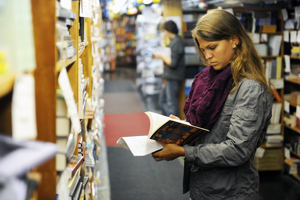Scholastic generation
Books still hold their own.
By Amy Braverman Puma
Photography by Dan Dry

Can’t wait for class: Chicago students love the feel of books.
As soon as I pulled it out of my son’s preschool cubby, I recognized its newsprint pages and bright book covers: a Scholastic book catalog. They still have this? My three-year-old is getting it? While he waited for help with his jacket, I had a memory flash of my grade-school teachers passing out the catalogs. I’d circle the books I wanted, negotiate with my parents over how many to order, and wait weeks for them to arrive.
On Scholastic’s website that night (you can also order online), I saw that the company still sells Where the Red Fern Grows for ages 12-plus, one of my favorite purchases. The pre-K options were no less fun to peruse: Mouse’s First Fall; Alexander and the Terrible, Horrible, No Good, Very Bad Day; There Was an Old Lady Who Swallowed a Fly. Corduroy, Clifford, Froggy. Books about Halloween, dinosaurs, planets, animals. This time I’d have to negotiate with myself. We got 11 books, including a set of six for $10, Chicka Chicka Boom Boom for my son’s class, and Pat the Bunny for his baby sister. If I’d known he’d get a new catalog every month, I might have eased up. Still, the total was only $32.
When the books came in—less than a week later—my son asked to read them all. The old lady who swallowed a fly, he decided, is scary looking (and so stays in the closet with The Giving Tree, whose back-cover photo of Shel Silverstein also upsets him). His favorites were the Halloween stories.
Will books always be exciting for my kids? Will electronic formats render them extinct? Looking ahead a few years, I asked some students at the Seminary Co-op, buying their fall-quarter course books. First-year Peter Tuong was leaving the store carrying a hefty Wealth of Nations—a classic, if not a page-turner. He needed it for sociology: Power, Identity, and Resistance. Although he’d bought most of his books on Amazon, he’d gotten the wrong edition of Adam Smith and came to the Co-op for the right one. He doesn’t see himself replacing books with a Kindle or an iPad. “I highlight,” he said, “and whip out a book when I’m doing papers. A screen is not the same.”
Inside, two more first-years, both scanning the sociology shelves for Self, Culture, and Society, agreed. “I like to hold a book in my hand,” said Moe Nakayama, who spent almost $300 on books this quarter (“mostly because of my huge math textbook,” she said). The guy near her, Ryan Urbano, was eager to read The Waste Land and The Metamorphosis (but, like Tuong, he too had first purchased a wrong edition).
The students gave me hope. And Co-op manager Jack Cella, X’73, at the information desk, added to it. Despite changes in how people buy books—especially expensive textbooks—they’re still buying. “It’s good for people to have choices,” he said. A computer calculation showed that unit sales the previous week ran ahead of the same period last year. “We’ve talked with a lot of students the last few days,” he said, “and many are enthusiastic about shopping locally.”
It was a nice reminder to shop locally. I skipped the October Scholastic catalog, although I’m sure we’ll exercise that nostalgic option again. Right now the kids’ bookcase is full.
Brooks will be the judge
In his New York Times columns, David Brooks, AB’83, exudes evenhandedness—and, we hope, inspires clever parody. If you think you can out-Brooks Brooks, see Lite of the Mind for details about our Brooks-column parody contest.—A.B.P.
